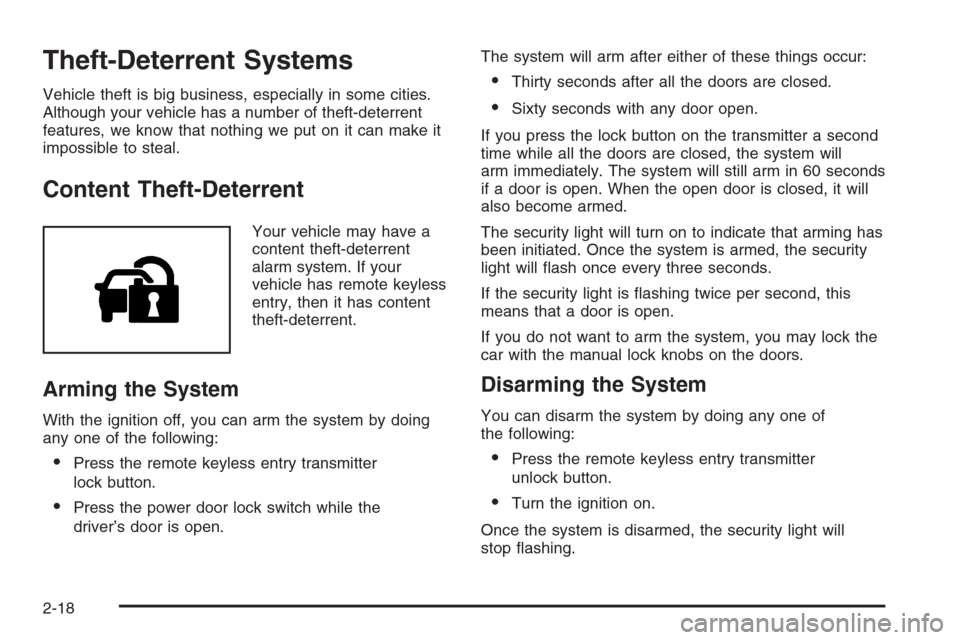Page 88 of 394

Q(Lock):Press the lock button to lock all the doors.
The interior lamps will turn off after all of the doors
are closed. If enabled through the Driver Information
Center (DIC), the parking lamps will �ash once to
indicate locking has occurred. If enabled through the
DIC, the horn will also chirp to indicate locking has
occurred. Pressing the lock button may arm the content
theft-deterrent system. SeeContent Theft-Deterrent
on page 2-18.
"(Unlock):Press the unlock button to unlock the
driver’s door. If the button is pressed again within �ve
seconds, all remaining doors and the liftgate will unlock.
The interior lamps will come on and stay on for
20 seconds or until the ignition is turned on. If enabled
through the DIC, the hazard lamps will �ash twice
to indicate unlocking has occurred and if it is dark
outside, the high beams and parking lamps will turn on
and stay on for 20 seconds or until a door is opened.
See LIGHT FLASH and EXT (Exterior) LIGHTS
underDIC Vehicle Personalization on page 3-45for
additional information.
L(Vehicle Locator/Panic Alarm):This button may
be used to locate your vehicle. Press and release
this button to activate the vehicle locate feature.The horn will chirp three times and the headlamps and
parking lamps will �ash three times. Press and hold
the button for three seconds to sound the panic alarm.
The horn will chirp and the headlamps and parking
lamps will �ash for 30 seconds. Press the button again
to cancel the panic alarm.
Programmable Horn Chirp
Through the DIC, you may choose whether or not to
have a horn chirp when you use the remote keyless
entry transmitter to lock or unlock the doors. See “LOCK
HORN” and “UNLOCK HORN” underDIC Vehicle
Personalization on page 3-45for more information.
Matching Transmitter(s) to
Your Vehicle
Each remote keyless entry transmitter is coded to
prevent another transmitter from unlocking your vehicle.
If a transmitter is lost or stolen, a replacement can
be purchased through your dealer. Remember to bring
any remaining transmitters with you when you go to
your dealer in case they need to be re-coded.
Each vehicle can have a maximum of four transmitters
matched to it.
2-6
Page 100 of 394

Theft-Deterrent Systems
Vehicle theft is big business, especially in some cities.
Although your vehicle has a number of theft-deterrent
features, we know that nothing we put on it can make it
impossible to steal.
Content Theft-Deterrent
Your vehicle may have a
content theft-deterrent
alarm system. If your
vehicle has remote keyless
entry, then it has content
theft-deterrent.
Arming the System
With the ignition off, you can arm the system by doing
any one of the following:
Press the remote keyless entry transmitter
lock button.
Press the power door lock switch while the
driver’s door is open.The system will arm after either of these things occur:
Thirty seconds after all the doors are closed.
Sixty seconds with any door open.
If you press the lock button on the transmitter a second
time while all the doors are closed, the system will
arm immediately. The system will still arm in 60 seconds
if a door is open. When the open door is closed, it will
also become armed.
The security light will turn on to indicate that arming has
been initiated. Once the system is armed, the security
light will �ash once every three seconds.
If the security light is �ashing twice per second, this
means that a door is open.
If you do not want to arm the system, you may lock the
car with the manual lock knobs on the doors.
Disarming the System
You can disarm the system by doing any one of
the following:
Press the remote keyless entry transmitter
unlock button.
Turn the ignition on.
Once the system is disarmed, the security light will
stop �ashing.
2-18
Page 101 of 394

How the System Alarm is Activated
If the system is armed, it can be activated by either:
Opening the driver’s door or tailgate. This will cause
a ten second pre-alarm chirp followed by a thirty
second full alarm of horn and lights.
Opening any other door. This will immediately
cause a full alarm of horn and lights for thirty
seconds.
When an alarm event has �nished, the system will
re-arm itself automatically.
How to Turn Off the System Alarm
To turn off the system alarm, do one of the following:
Press the lock button on the remote keyless
entry transmitter. The system will then re-arm itself.
Press the unlock button on the remote keyless entry
transmitter. This will also disarm the system.
Insert the key in the ignition and turn it on. This will
also disarm the system.
How to Detect a Tamper Condition
If you hear three chirps when you press the unlock or
lock buttons on the remote keyless transmitter, it means
that the content theft security system alarm was
previously activated.
PASS-Key®III+
The PASS-Key®III+ system operates on a radio
frequency subject to Federal Communications
Commission (FCC) Rules and with Industry Canada.
This device complies with Part 15 of the FCC Rules.
Operation is subject to the following two conditions:
1. This device may not cause harmful interference.
2. This device must accept any interference received,
including interference that may cause undesired
operation.
This device complies with RSS-210 of Industry Canada.
Operation is subject to the following two conditions:
1. This device may not cause interference.
2. This device must accept any interference received,
including interference that may cause undesired
operation of the device.
Changes or modi�cations to this system by other than
an authorized service facility could void authorization to
use this equipment.
PASS-Key
®III+ uses a radio frequency transponder in
the key that matches a decoder in your vehicle.
2-19
Page 156 of 394

Warning Lights, Gages, and
Indicators
This part describes the warning lights and gages that
may be on your vehicle. The pictures will help you
locate them.
Warning lights and gages can signal that something is
wrong before it becomes serious enough to cause
an expensive repair or replacement. Paying attention to
your warning lights and gages could also save you
or others from injury.
Warning lights come on when there may be or is a
problem with one of your vehicle’s functions. As you will
see in the details on the next few pages, some
warning lights come on brie�y when you start the
engine just to let you know they’re working. If you are
familiar with this section, you should not be alarmed
when this happens.Gages can indicate when there may be or is a problem
with one of your vehicle’s functions. Often gages and
warning lights work together to let you know when
there’s a problem with your vehicle.
When one of the warning lights comes on and stays on
as you are driving, or when one of the gages shows
there may be a problem, check the section that tells
you what to do about it. Please follow this manual’s
advice. Waiting to do repairs can be costly — and even
dangerous. So please get to know your warning
lights and gages. They’re a big help.
3-24